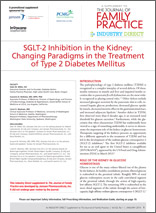The pathophysiology of type 2 diabetes mellitus (T2DM) is recognized as a complex interplay of several defects. Of these, insulin resistance in muscle and liver and impaired insulin secretion due to pancreatic b-cell dysfunction are the most widely recognized as playing central roles.1-3 Other defects include increased glucagon secretion by the pancreatic islet a-cells, increased hepatic glucose production, decreased glucose uptake by muscle, decreased incretin effect in the gastrointestinal tract, and increased adipocyte lipolysis.

Medical Education Library
SGLT-2 Inhibition in the Kidney: Changing Paradigms in the Treatment of Type 2 Diabetes Mellitus
J Fam Pract. 2014 January;63(1):S1-S32
This INDUSTRY DIRECT supplement to The Journal of Family Practice is brought to you by Janssen.

